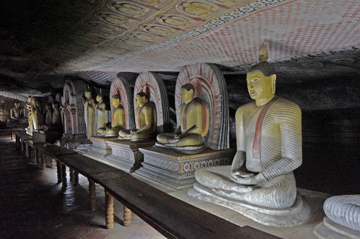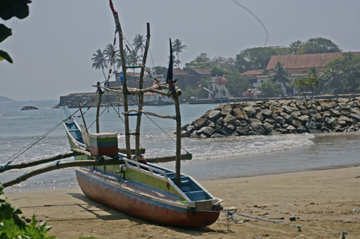Seductive Sri Lanka
 This pearl-shaped island off the southeastern tip of India was know as Ceylon under British rule in the time of the Raj, who took over from the Dutch and Portuguese before them, and before that simply as Lanka by the native Sinhalese. This paradise of beaches, tropical jungle and ancient ruins has become a hot destination--Lonely Planet named it best emerging destination in 2013.
This pearl-shaped island off the southeastern tip of India was know as Ceylon under British rule in the time of the Raj, who took over from the Dutch and Portuguese before them, and before that simply as Lanka by the native Sinhalese. This paradise of beaches, tropical jungle and ancient ruins has become a hot destination--Lonely Planet named it best emerging destination in 2013.
From a traveler’s perspective, it's currently a somewhat time-warped view into Asia 30 plus years ago. Tourism is starting to bloom the last few years, where there was virtually none for three decades prior. The near 30-year civil war between the Sinhalese government forces and the Tamil Tiger separatist revolutionaries devastated the country. The war’s end in 2009 has slowly brought a return to normalcy, and the return of intrepid travelers. Tourism was up sharply in 2011, and the island is becoming a sought-after destin ation.
ation.
Sri Lanka has much to offer for those seeking this sort of travel. Beautiful green vistas, jungle covered mountains, tropical flowers and birds, many historical sites--temples, royal cities, ancient ruins--including eight UNESCO World Heritage sites, and miles of sugar-sand beaches for those seeking sun, sea and relaxation. And at least for the next couple of years, visitors will benefit from being fairly early, before the biggest traveler surge, since the government hopes to double the number of tourists the next three years. There are dozens of luxury hotels under development, and bigger crowds and a goodly amount of Disney-fication, ala Bali are probably unavoidable.
 The central north, or Cultural Triangle is the location of two royal seats of power covering hundreds of years, between the 4th century BC and the 11th century AD--Anaradhapura and Pollonnaruwa. Palace ruins, monasteries that housed 3,000 monks, Buddhist temples, enormous white stupas and statues abound. Emerald swaths of rice paddies and thick jungle backed by craggy mountain peaks with billowing clouds in cornflower blue skies are a travel photographers dream.
The central north, or Cultural Triangle is the location of two royal seats of power covering hundreds of years, between the 4th century BC and the 11th century AD--Anaradhapura and Pollonnaruwa. Palace ruins, monasteries that housed 3,000 monks, Buddhist temples, enormous white stupas and statues abound. Emerald swaths of rice paddies and thick jungle backed by craggy mountain peaks with billowing clouds in cornflower blue skies are a travel photographers dream.
In the north and south there are national parks and game reserves home to dozens of animal species, including much birdlife, leopards and most notably a Sri Lankan specific variety of the Asian elephant, several thousand of which still roam the island. For elephant lovers, an annual spectacle known as The Gathering occurs in Minneriya National park when hundreds of elephants converge on one specific watering hole for several weeks.
Colonial Kandy in the central mountains has a lovely old quarter, central lake and offers a view into the architecture and times of the British Raj and the era of vast plantations of rubber and tea. It's also the holiest site on the island, with the Temple of the Sacred Tooth Relic, said to contain the very tooth of the Buddha. The Tea Museum a few kilometers outside Kandy, set in a tea plantation, offers a picture of the tea trade and tea process from Victorian times and obviates needing to take time to climb further into the hills to the main tea growing area at Nuwara Eliya.
 Another UNESCO site, Fort Galle, on the south coast, is a wonderful mixture of historic Dutch, Portuguese and British architecture set within the massive surrounding fortified walls. Some restoration of the town has been completed, with much more under way, in the wake of both the 30 year war and the Boxing Day tsunami of 2004. Quite a number of derelict wrecks sit waiting for fortune, and our guide Juliet Coomb, an English journalist who was sent to cover the tsunami and married her translator, an 8th generation Fort dweller, says that Fort residents worry about such “opportunities” being sold to foreigners for vacation homes, and changing the old residential character of the town. Catholic, Baptist and Methodist churches, Buddhist temple and a Mosque add architectural interest to the fortified town, and all cater to the religious affiliations of the Fort’s 1200 inhabitants.
Another UNESCO site, Fort Galle, on the south coast, is a wonderful mixture of historic Dutch, Portuguese and British architecture set within the massive surrounding fortified walls. Some restoration of the town has been completed, with much more under way, in the wake of both the 30 year war and the Boxing Day tsunami of 2004. Quite a number of derelict wrecks sit waiting for fortune, and our guide Juliet Coomb, an English journalist who was sent to cover the tsunami and married her translator, an 8th generation Fort dweller, says that Fort residents worry about such “opportunities” being sold to foreigners for vacation homes, and changing the old residential character of the town. Catholic, Baptist and Methodist churches, Buddhist temple and a Mosque add architectural interest to the fortified town, and all cater to the religious affiliations of the Fort’s 1200 inhabitants.
There are words of caution to the potential Sri Lankan visitor. The average temperature in the coolest months, January and February, is in the high 80's, with fairly high humidity, and the midday sun on days that aren't cloudy is fierce. This is heaven to one of us, who loves heat and humidity, and hell to the other, who detests same. Many of the most important sites involve staggering climbs up literally hundreds and thousands of granite steps--1843 of them in the case of Mihintale, a hilltop temple where Buddhism first came to Sri Lanka, over 1200 at Sigiriya, an important and stunning ruin atop a soaring plug of granite, and 364 to the cave temples at Dambulla.
And unless your budget runs to private helicopter transfers, it takes many hours of slow travel by car over mostly rough roads stuck behind diesel buses and trucks, tuktuks, motorbikes packed with families of 4, and cows and dogs to get from the entry point at Colombo to the historical sites of the north central, back to colonial Kandy and the highlands, and down to Fort Galle on the south coast. The scenery, village life, people are all interesting, and the distances aren’t all that long, but the bad roads and abundant traffic make these long slogs of hours on the road.
Small plane transfers between major regions will probably become available at not cheap but less than astronomical prices, but for the moment one of the prices to pay to see most everything is lots of hours on the road.
And while Sri Lanka has several large national parks with lots of wildlife--including the largest gathering of elephants in a single place anywhere in the world at Minneriya in August—the parks seem already to be overrun with visitors, and the government appears unwilling to impose daily limits. After a couple of hours bouncing around in jeeps in Kaudulla Park, we found a herd of 30-40 elephants that had come out of the forest, heading for water, and through the curse of cell phone communication, by the time we left there were over 40 jeeps surrounding the herd. In Yala park in the south, the statistics for the highest recorded visitor day ever in 2013 were 3,300 visitors, and over 500 jeeps roaming the park. This is not a good situation...if you've had any real Africa experience, opt out of game viewing for other of the beauties of the country.
elephants in a single place anywhere in the world at Minneriya in August—the parks seem already to be overrun with visitors, and the government appears unwilling to impose daily limits. After a couple of hours bouncing around in jeeps in Kaudulla Park, we found a herd of 30-40 elephants that had come out of the forest, heading for water, and through the curse of cell phone communication, by the time we left there were over 40 jeeps surrounding the herd. In Yala park in the south, the statistics for the highest recorded visitor day ever in 2013 were 3,300 visitors, and over 500 jeeps roaming the park. This is not a good situation...if you've had any real Africa experience, opt out of game viewing for other of the beauties of the country.
Hotels of Note:
Wallawa – a tranquil oasis outside of Colombo in a lovingly restored plantation owner’s house. Great restaurant with extensive menu.
Ulagalla – near Anaradhapura – 20 separate chalet-suites dotted across almost 60 acres of rice paddies and tropical forests filled with birdsong.
Kandy House – Kandy – a 200-year old colonial ancestral home of one of Kandy’s old aristocratic families. Opt for an Ultra room with private butler.
Amangalla– Fort Galle – the New Oriental Hotel – the longest continually operating hotel in Asia was taken over several years ago by Aman resorts and renovated into a very luxurious colonial style hotel overlooking the ramparts of the Fort. Breakfast and High Tea seated on historic furniture on the tiled veranda, ceiling fans lazily circling overhead. A quite, palm-shaded pool area where breakfast and lunch can be taken.
Tintagel – Colombo – a secluded art-deco mansion in the heart of Colombo, formerly the home of three different Sri Lankan Prime Ministers. Rooms and décor are lovely, and the kitchen is fantastic, but they’ve had trouble getting a liquor license due to proximity to a girl’s school, so check if that’s changed, and stock up in duty free otherwise.